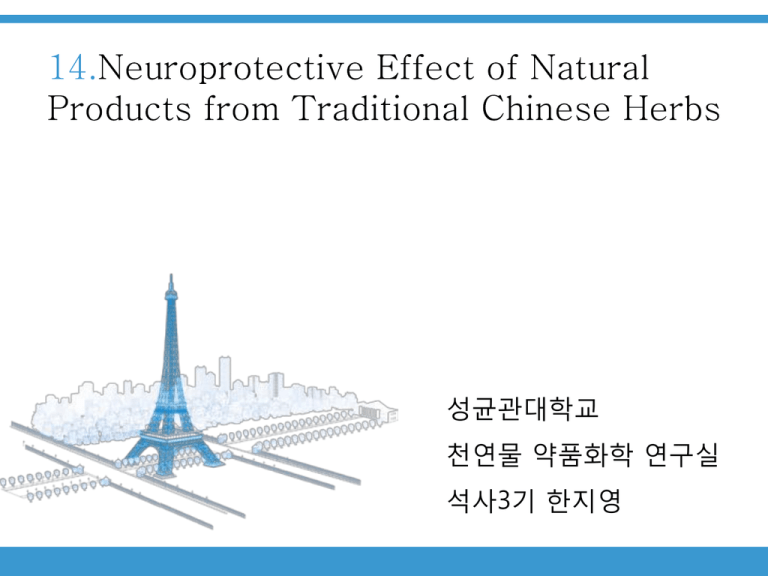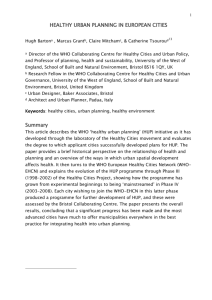PowerPoint ****** - 성균관대학교 이강노교수 천연물 약품화학 연구실
advertisement

성균관대학교 천연물 약품화학 연구실 석사3기 한지영 • Given the expected dramatic increase in the incidence and prevalence of of many agerelated neurodegenerative diseases(NDs), the identification of successful prevention and treatment strategies is critical. • Several common abnormalities have been abserved in the pathogenesis of NDs, which include oxidative stress, mitochondrial dysfunction, protein aggregation and misfolding, inflammation, excitotoxicity, as well as apoptosis • These pathogenic alterations likely act synergistically through complex interactions to promote neurodegeneration. Thus, it becomes evident that syndromes, such as AD and PD, will require multi-target drug therapy to address the varied pathological aspects of the disease. • China is a country with abundant storage of various species of chinese herbs, decoctions of which have been proved to be effective for many specific symptoms in Chinese literatures like A Chinese Bestiary, the Medical Classic of the Yellow Emperor. traditionally used for traumatic injury, detoxification , pain relief, as well as schizophrenia. Huperzia serrata (뱁톱과 와 송) Acetylcholinesterase(AChE) inhibitor Shows higher potency and selectivity of AChE inhibition in vivo as compared with galanthamine, donepezil, and rivastigmine, which are approved by food and drug administration(FDA) for AD treatment Galanthamine Donepezil Rivastigmine • Hup A has an eight- and twofold higher potency for increasing cortical AChE level than donepezil and rivastigmine, respectively, with a longer duration of action and fewer side effects. • Hup A-TcAChE complex, which revealed that the "ingenious design" of Hup A has a tighter binding and greater specificity to the AChE enzyme than other known AChE inhibitors, such as tacrine. • Hup A - improve the memory, cognitive skills, and daily life abilities of AD patients with mild to no side effects. • Hup A - neuroprotective activities such as regulating β –amyloid precursor protein(APP) metabolism - counteracting neurotoxicities, - induced by many neurotoxins, - including β-amyloid (AB) peptide, - improving mitochondrial function. • Hup A has been proved to enhance nonamyloidogenic pathway by increasing the levels of sAPPα and PKCα , which is mediated via two divergent Transduction pathways that converge at a step of tyrosine phosphorylation: a PKC-dependent pathway and a Pas/MAPK dependent pathway. • Hup A - decrease amyloidogenic pathway - increased sAPPα secretion is associated with the reduction of Aβ generation. - pretreatment of cells with Hup A prior to Aβ or hydrogen peroxide(H2O2) exposure was found to enhance the cell survival and the activities of antioxidant enzymes, including glutathione peroxidase(G SH-Px), superoxide dismutase(SOD), and catalase( CAT), and decrease the level of lipid peroxidation product malondialdehyde(MDA) •Hup A - on mitochondrial dysfunction in Aβ-exposed PC12 cells or isolated mitochondria, - reducing the levels of reactive oxygen species( ROS) as well as increasing the activities of key components of the respiratory chain and key enzymes in TCA cycle - increasing ATP production, reducing mitochondrial swelling, and maintaining membrane integrity. - improve the memory impairment in patients with vascular dementia( VaD), mild cognitive deficits, as well as schizophrenia • Hup A can ameliorate acute inflammation in transient focal cerebral ischemic rats or in oxygenglucose-deprived C6 cells and chronic inflammation in cerebral hypoperfusion rats induced by occlusion of bilateral common carotid arteries or in hypoxia-induced BV-2 cell. The neuroprotective effects of Hup A might be due in part to a cholinergic anti-inflammatory pathway, involving nicotinic acetylcholiner eceptor( nAChR). • Hup A can slow the rate of recovery from desensitization of the α7 containing nAChRs in rat hippocampal interneurons and increase both the amplitude and decay time of non- α 7 nAChRsmediated responses through an indirect mechanism involving the inhibition of the breakdown of ACh, resulting in an enhanced amount of duration of ACh exposed to these channel • ZT-1, a semisynthetic derivative of Hup A, - The AChE inhibitory effect of ZT-1 is almost as potent as that of Hup A, - while its potency in inhibiting human serum butyrylcholinesteraes(BuChE) is less than that of Hup A • In mild to moderate AD patients, both ZT-1 And donepezipl proved to be similarly effective in cognitive improvement. • huperzine B - reversible AChE inhibitor exhibiting more selective inhibition on AChE activity than galanthamine in vitro. - protect cells against H2O2, and oxygen glucose deprivation - partly due to elevating antioxidant enzyme activities and decreasing MDA level. - demonstrated to antagonize cerebral NMDA receptor, besides its inhibitory effect on AChE • FS-0311 - high oral bioavailability and a long duration of AChE inhibitory action in vivo. - found to antagonize cognitive deficits induced by scopolamine or transient brain - Ischemia and reperfusion in a water mazetask. - possessed the ability to protect PC12 cells against Aβ peptide induced toxicity, OGD insult, and staurosporineinduced apoptosis. - appeared to reflect an attenuation of oxidative stress. Sinomenii Caulis(한방기) • Used for thet reatment of rheumatoid arthritis due to its anti-inflammation and analgesic activity. • SN has been used clinically as an anti-inflammatory agent in several inflammation-related disease. • It can markedly reduce the production of pro-inflammatory mediators ,such as TNF-α, IL-1, PGE2, and NO from macrophages, which might be due to the inhibition of superoxide production through the inhibition of microglial PHOX activity. • S-52,one of the derivatives of SN synthesized in this institute by Prof. Guowei Qin, was found to exert many neuroprotective effects. •This semisynthetic compound could also markedly elevate cortical ACh level with no AChE inhibitory Effect. • S-52 could significantly increase the cell viability in Aβ or glutamate-induced cell injury models, which might be due to regulating the activities of anti-oxidative enzymes, including SOD, GSH-PX, CAT, Reducing the lipid peroxidation products-MDA ,alleviating ROS production, increasing ATP level, as well as regulating the mitochondrial function through increasing the activities of respiratory chain complexes and TCA enzymes S-52 could significantly alleviate scopolamine or ischemiainduceds patiall earning deficits in mice • Galanthamine was reported to be a selective, reversible, and competitive inhibitor of AChE. It inhibits AChE activity at submicromolar concentrations, which is less than Hup A and donepezil but more potent than rivastigmine. • galanthamine can also afford neuroprotection against H2O2-induced toxicity, which may involve alleviating oxidative stress , potentiating NMDA receptor, upregulating anti-apoptotic proteins expression, as well as blocking delayed rectifler, but not transient outward potassium current • galanthamine may involve an additional mechanism, most likely allosteric modulation of nicotinic acetylcholine receptors (nAChRs). • galanthamine have been found in many brain ischemic models, which may involve attenuation of the release of inflammatory cytokines, and possibly mediated by nAChRs. • The herb is traditionally used as preventive medicine, but has exceptional therapeutic benefits for several medical conditions • Recently, ginseng decoction could significantly improve the cognitive function in AD patients panax ginseng(인삼) • The main active components of Panax ginseng are ginsenosides ,which are triterpene saponins • Rg1 is able to significantly enhance cholinergic function through increasing ACh level and density of muscarinic ACh receptor. • It also has other potential neurotrophic and neuroprotective effects, which may involve the blockade of inflammation cascade, calcium channels and cell apoptosis, the regulation of NGF, reduction of oxidative stress, as well as the amelioration of mitochondrial dysfunction. • Rg1 could improve learning and memory in normal, aged animals, as well as in various animal models with impaired memory induced by alcohol, AB, scopolamine, and ischemia. • recents tudies also indicated that Rg1 could attenuated opamine-induced apoptosisin PC12 cells and modulate COX-2 expression through the P38 signaling pathway in the substantia nigra of PD mice induced by MPTP. • Rg1 has been also proved to have estrogen-like activities and exert neuroprotective effects on the dopaminergic neurons in the 6-OHDA-induced ovariectomized(ovx) rat model of PD, •which may at least,i n part, be attributedt o its effects on attenuatingi ron overload •And apoptosis • Rgl on dopaminergic neurons in the 6-OHDA model of nigrostriatal injury could involve the activation of the IGF-IR signaling pathway. • It was traditionally believed in Chinese folk to alleviate hypertension, vertigo, headache, redness in the face and eyes, swelling and pains. • In cultured neuronal cells, L -NBP was found to markedly reverse Aβinduced apium graveolens(샐러리) •Nuclear fragmentation and early apoptosis, probably through inhibiting tau protein hyperphosphorylation. which may involve disturbing oxidative stress insults via reversing the reduction of GSH-Px activities and over production of MDA levels in the cortex and hippocampus, and inhibiting neuronal apoptosis possibly by blocking caspase-3 activation. • L-NBP could ameliorate learning and memory deficits in aged rats or after bilateral permanent occlusion of the common carotid arteries In, which may be mediated through enhancing ChAT activity, reducing expression of BACE and tau hyperphosphorylation. L-3-n-butylphthalid •Besides inhibiting BACE expression and tau hyperphosphorylation, the underlying mechanism might also involve microvessel improvement possibly via increasing the ratio of PGI2/TXA2, 2nhancing the activity of antioxidative enzymes, improving mitochondrial function, inhibiting lipidperoxidation, blocking platelet aggregation, increasing regionalc erebral blood flow. DL-3-n-butylphthalide (DL-NBP) has been shown to exert its protective actions against ischemic brain tissue through multiple mechanism, such as protection of mitochondria and regulation of energy metabolism, decrease of oxidative damage, reduction of neuronala poptosis and inhibition of the inflammatory response, inhibition of platelet aggregation, as well as improvement of rat brain microcirculation. • Gingko biloba - In China as a traditional medicine in ameliorating blood circulation for thousand years. - Leaf contains 24% flavonoids and 6% terpene lactones, which is a mixture of many active components including ginkgolides, bilobalide, ginkgolic acid, as well as KYNA and 6-HKA - Used in china for treating cardiovascular diseases, strokes, and complications caused by brain trauma. • Green tea - reduced onset of cardiovascular disease, obesity, and cancer, as well as a slowing down of the aging process • Tripterygium wilfordii Hook F - treatment of ND, especially PD. - Reduction of inflammation, inhibition of apoptosis, reduction of oxidative stress, stimulation of the expression and release of NGF •Carthamus tinctrorius(safflower) - Prevention and treatment of cardiovascular disease and thrombosis in china







